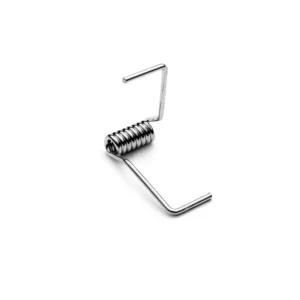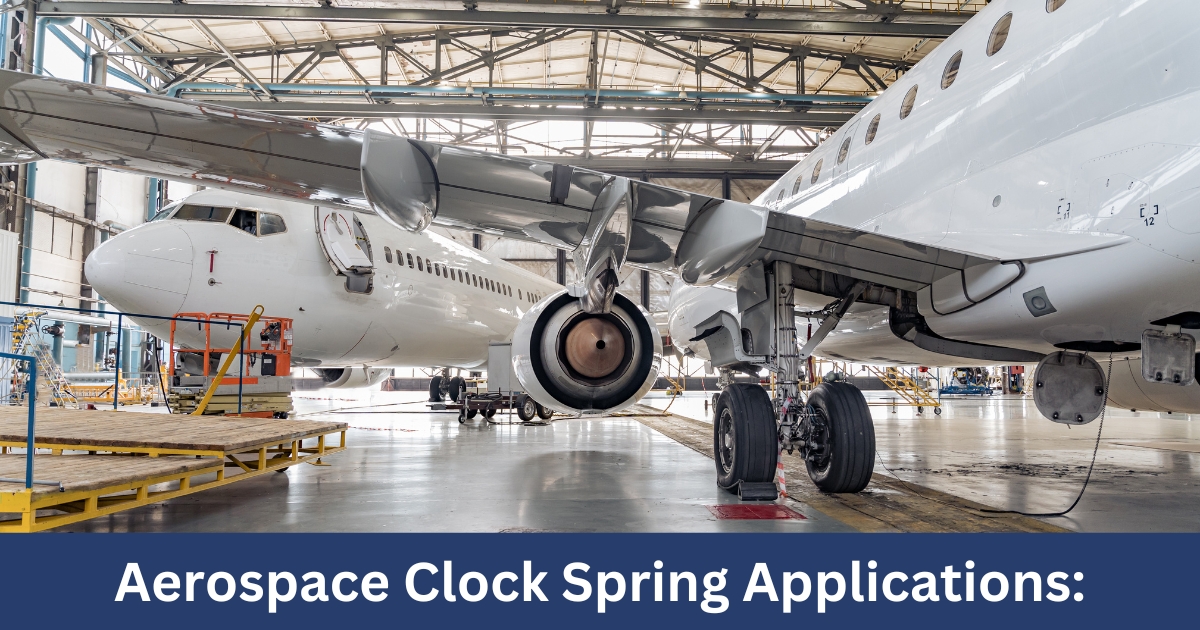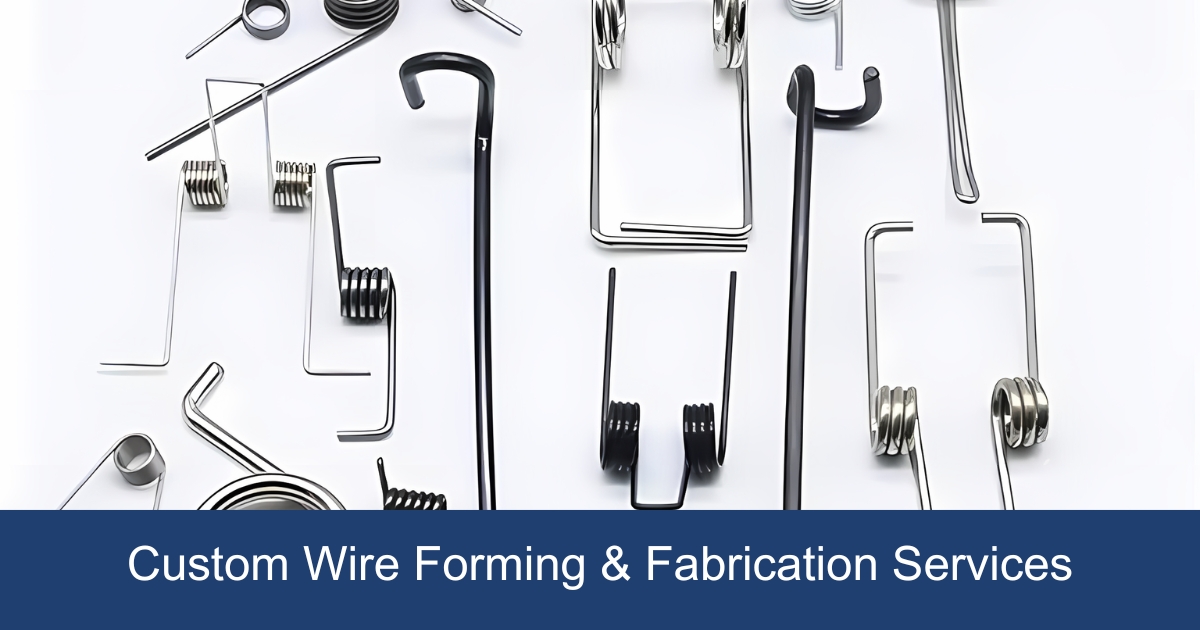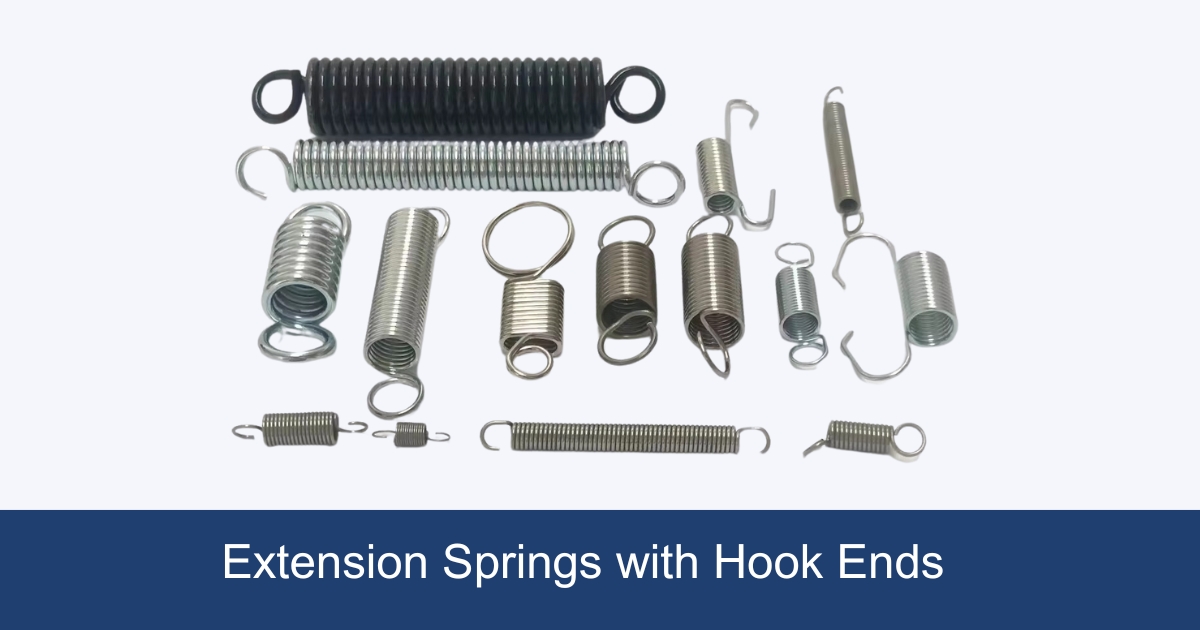Torsion springs, pivotal in delivering twisting force or torque when they’re twisted along their axis, stand at the core of countless mechanical applications ranging from everyday items like door hinges and garage doors to more specialized uses in automotive and aerospace industries.
This comprehensive guide aims to explore the myriad of torsion spring uses, delving into how these springs work, their lifespan, and their role in daily life, industry, and beyond.

How Torsion Spring Works?
Understanding how torsion springs work is pivotal in appreciating their widespread applications, from the smooth operation of garage doors to their critical role in automotive systems. Here’s a breakdown of their mechanism and design:
- Energy Storage and Release: Torsion springs function by storing mechanical energy when twisted. The spring is made of wire wound in a spiral shape, with one end attached to a stationary point and the other to a rotating point. When the rotating point is turned, the spring stores energy by twisting. Once the rotating force is released, the spring unwinds, releasing the stored energy in the opposite direction.
- Angular Movement: These springs are designed for angular movement, with two attached legs connecting to other components. Upon rotation of these components, the spring exerts a rotary force (torque) to return to its original resting position, showcasing its ability to store and release angular energy or statically hold a mechanism in place by deflecting the legs about the body centerline axis.
How Long Do Torsion Spring Last?
The lifespan of a torsion spring can vary widely depending on several factors, including the quality of the material, the design of the spring, the environment in which it operates, and the frequency of its use. On average, torsion springs are designed to last for approximately 10,000 to 20,000 cycles, with one cycle being a single use of the door opening and closing for garage door springs, for example. This typically translates to about 7 to 12 years for residential use under normal conditions. However, springs used in industrial or high-frequency applications may have a shorter lifespan due to increased wear and tear. Proper maintenance and adjustments can extend the life of a torsion spring.
Torsion Springs Common Uses in Daily Life
Torsion springs, integral to a myriad of daily applications, span from the simplicity of household items to the complexity of industrial machinery. Their versatility is showcased in various settings:
- Household and Personal Use:
- Clothespins and Clipboards: The clamping action in clothespins and the powerful hold in clipboards are facilitated by torsion springs, making these everyday items functional and reliable.
- Watches and Clocks: In timekeeping devices, torsion springs suspend wheel-shaped weights, enabling the continuous motion necessary for accurate timekeeping.
- Toys: The engaging movement in many toys, requiring a rotating force, is often powered by torsion springs, adding a dynamic element to playtime.
- Commercial and Industrial Applications:
- Door Hinges and Garage Doors: Particularly in commercial and industrial settings, torsion springs play a critical role in door hinges and garage doors, counterbalancing weights to ease lifting and lowering actions.
- Automotive Doors and Tailgates: The smooth operation of automobile doors, residential doors, and the heavy-duty doors found in warehouses is attributed to torsion springs, allowing these doors to return to their original position effortlessly.
- Medical Equipment and Industrial Machinery: The precision and reliability required in medical devices and various types of industrial machinery are often achieved through the application of torsion springs.
- Specialized and Outdoor Equipment:
- Rock Climbing Devices (SLCDs): Torsion springs are used in camming devices for rock climbing, providing safety and reliability in mountaineering protection.
- Stainless Steel Springs in Watercraft: To combat corrosion in humid environments, stainless steel torsion springs are utilized in personal watercraft boarding steps, showcasing their durability and resistance to harsh conditions.
- Retractable Seating in Stadiums: The functionality of lifting and retracting seats in stadiums, which facilitates evacuation and cleaning, is made possible through the use of torsion springs.
This broad spectrum of applications, from the mundane to the specialized, underscores the torsion spring’s indispensable role in enhancing functionality and improving the efficiency of mechanisms in our daily lives. Their adaptability and reliability make them a cornerstone in the design and operation of a wide array of products, reflecting their importance across various sectors.
Torsion Springs in the Automotive Industry
In the automotive industry, torsion springs play a pivotal role, particularly favored for their durability and resistance to harsh chemical substances. These springs, often made from chrome silicon, are integral to the smooth operation and safety of vehicles. Here’s a closer look at where torsion springs make their mark in automotive applications:
- Vehicle Suspension Systems:
- Absorbs shocks from road irregularities, ensuring a smoother ride.
- Maintains vehicle stability and handling, contributing to driver and passenger safety.
- Chassis:
- Provides the necessary flexibility in the vehicle’s structure, enhancing durability.
- Assists in evenly distributing the weight of the vehicle, crucial for maintaining balance and stability.
- Automotive Valves:
- Ensures the timely opening and closing of valves for efficient engine operation.
- Plays a critical role in managing the engine’s air-fuel mixture, directly impacting vehicle performance and emissions.
- Clutches and Gear Shifters:
- Facilitates smooth gear transitions, vital for manual transmission systems.
- Enhances driver control over the vehicle, allowing for a responsive and engaging driving experience.
The widespread use of torsion springs in these components underscores their importance in ensuring vehicles operate efficiently, safely, and reliably. By leveraging the unique properties of chrome silicon, automotive engineers can design torsion springs that withstand the rigorous demands of vehicle operation, from high-speed performance to off-road durability. This adaptability and reliability make torsion springs an indispensable component in the automotive industry, contributing to the advancement and refinement of automotive technology.
Role in Garage Doors and Home Applications
In the realm of home applications, particularly garage doors, torsion springs play a crucial role in both functionality and safety. Understanding their operation, maintenance, and the caution required during their replacement can ensure a smooth and safe experience for homeowners. Here’s a closer look at the critical aspects:
- Maintenance and Inspection:
- Regular checks can reveal early signs of wear, allowing for timely intervention.
- It’s advisable to replace garage door springs in pairs to maintain balance and prevent potential damage.
- Replacement Considerations:
- Due to the high tension under which torsion springs operate, specialized tools and expertise are essential for safe replacement.
- A compromised torsion spring can lead to the garage door closing unexpectedly, posing risks of injury or property damage.
- Functionality and Design:
- Torsion springs, mounted horizontally above the door opening, facilitate the door’s return to its original position by storing energy when the door is lifted.
- The energy stored is slightly less than the door’s weight, easing manual lifting.
- A shaft connected to the spring rotates as the garage door is raised, highlighting the intricate design that matches the spring’s stored energy to the door’s weight for optimal performance.
This segment underscores the pivotal role of torsion springs in ensuring the efficient and safe operation of garage doors, a common yet essential feature in many homes. Proper maintenance, cautious replacement, and a fundamental understanding of their mechanism can significantly enhance the longevity and functionality of garage doors, making torsion springs an indispensable component in home applications.
Innovative Uses in Medical Devices
In the healthcare industry, the application of torsion springs is both innovative and critical, ensuring the functionality and reliability of various medical devices. These springs, especially those made from high-carbon steel, are chosen for their strength and durability, vital attributes in the medical field. Below is an overview of how torsion springs contribute to medical devices:
- Hospital and Dental Equipment:
- Hospital Beds and Wheelchair Lifts: Torsion springs are integral to the mechanics of hospital beds and wheelchair lifts, facilitating smooth adjustments and enhancing patient comfort and mobility.
- Dental Tools: In the realm of dentistry, torsion springs play a crucial role in devices requiring precise rotational movement, such as dental X-Rays, ensuring accurate positioning and control.
- Medical Devices:
- Medical Immobilization Devices: These devices often rely on torsion springs for secure and adjustable immobilization, crucial in patient recovery.
- Surgical Instruments: Torsion springs are used in a variety of surgical instruments, including staplers and lights, where controlled movement is essential.
- Diagnostic Equipment: Springs, particularly compression and torsion types, are foundational in the functionality of diagnostic equipment, providing the necessary force and movement for operations.
The versatility of torsion springs extends beyond traditional applications, adapting to the unique demands of medical technology:
- Specialized Medical Applications:
- Implantable Devices: Compression springs are specifically designed for implantable medical devices, offering constant force and minimizing resistance, which is critical for the device’s longevity and patient safety.
- Battery-Powered Medical Devices: Torsion leaf springs are utilized to establish a reliable physical connection between the battery and the device, ensuring consistent power supply.
- Medical Testing Instruments: Electrical contacts, like beryllium copper battery contacts, are crucial in devices such as glucose testing kits, where reliability and precision are paramount.
The integration of torsion springs into medical devices underscores their importance in the healthcare sector. Their application spans from enhancing the functionality of hospital beds to ensuring the precision of surgical instruments and the reliability of diagnostic equipment. This wide range of uses highlights the torsion spring’s adaptability and the critical role it plays in supporting health and wellness through medical technology.
Torsion Springs in Industrial Machinery
In the realm of industrial machinery, torsion springs play a pivotal role, underpinning the operation of heavy-duty equipment with their robust and reliable design. Companies like Airedale Springs and St. Mary’s Spring Company have carved niches in the manufacturing of these critical components, leveraging years of expertise and advanced materials to meet the demanding requirements of the sector.
- Manufacturing Expertise and Application:
- Airedale Springs: Specializes in a wide array of springs, including torsion springs, showcasing versatility in applications from small electronics to tension springs.
- St. Mary’s Spring Company: With over seventy years of experience, this company stands as a testament to the intricate design and manufacturing capabilities required for producing durable springs for industrial applications.
- Materials and Processes:
- Materials Used: The construction of torsion springs utilizes a variety of materials such as spring steels, stainless steels, alloy spring steels, copper-based, and nickel-based alloys, ensuring durability and resistance to wear and tear.
- Manufacturing Processes: The production journey of a torsion spring includes winding, heat treating for strength, grinding for precision, shot peening for stress resistance, and finishing for corrosion protection and longevity.
- Applications in Industrial Machinery:
- Agricultural Equipment: Large torsion springs find their use in tractor engines, sprayers, and ploughs, vital for the agriculture sector’s machinery.
- Construction Machinery: The durability and resistance of torsion springs support the long lifecycles of construction machinery, ensuring dependable operation under rigorous conditions.
The integration of torsion springs into industrial machinery is not just about their physical attributes but also about the expertise behind their design and production. Companies like Airedale Springs and St. Mary’s Spring Company exemplify the blend of innovation and tradition in the creation of springs that meet the exacting standards of industrial applications. From the materials selected to the manufacturing processes employed, each step is geared towards ensuring that torsion springs can withstand the challenges of heavy-duty use, making them an indispensable component in the machinery that powers industries worldwide.
Torsion Springs in Aerospace and Defence
In the aerospace and defense sectors, torsion springs are indispensable for their high-performance and safety-critical applications. These springs are engineered to meet rigorous standards, ensuring they can withstand extreme conditions while maintaining their integrity and functionality. Key suppliers like Vulcan Spring and Lee Spring are at the forefront, providing specialized products that cater to these industries’ unique needs.
- Applications in Aerospace and Defense:
- Vulcan Spring:
- Supplies a broad range of springs including Conforce®, Contorque®, and Power Springs.
- Notable contributions include custom-designed Conforce® springs for the James Webb Space Telescope, aiding in the precise tensioning of the Sunshield Membrane.
- Common applications span armaments, aircraft cockpits, solar panels for space satellites, and seat counterbalances in military vehicles.
- Lee Spring:
- Offers precision springs for landing gear systems, control surfaces, aircraft doors, and more.
- Renowned for supplying components that ensure durability, reliability, and customization to the Aerospace and Military industries.
- Vulcan Spring:
- Compliance and Certification:
- Associated Spring:
- Specializes in precision metal springs, adhering to stringent regulations like DFARS, D.D.T.C., and ITAR.
- Boasts an AS 9100 certification, guaranteeing the highest quality products for aerospace and defense applications.
- Associated Spring:
The role of torsion springs in aerospace and defense cannot be overstated. From enhancing the reliability and safety of aircraft during flight to providing critical support in landing gear systems, these springs counteract various forces that act on aircraft and defense equipment. The collaboration between industry leaders and manufacturers ensures that the aerospace and defense sectors continue to advance, leveraging the best in spring technology to meet their complex and demanding requirements.
Bespoke Torsion Springs for your specific application
Bespoke torsion springs are tailored to meet the precise needs of specific applications, combining high torque, durability, and a long lifespan. The customization process involves selecting the right material, leg configuration, and design specifications to ensure optimal performance. Key aspects of custom torsion springs include:
- Material Selection:
- Steel, Stainless Steel, and Alloys: Depending on the application, torsion springs can be made from a variety of materials, each offering unique benefits in terms of strength, corrosion resistance, and environmental adaptability.
- Chrome Silicone: Known for its resistance to environmental abuse and added strength, chrome silicone is an excellent choice for applications requiring high durability.
- Leg Configuration Options:
- Straight, straight offset, hinged, short hook end, and hook end designs cater to diverse project needs.
- Custom bends, twists, and hooked or looped ends are designed to match the specific requirements of the device or mechanism in question.
- Design and Specifications:
- Custom Dimensions: The inner diameter, outer diameter, wire diameter, body length, leg length, total coil, pitch, winding direction, leg angle, leg orientation, and leg style are tailored to provide the necessary torque and travel capabilities.
- Performance Parameters: Key factors such as spring index, angular deflection, maximum deflection, maximum load, spring rate, and stress are considered to ensure the spring meets the desired performance criteria.
In summary, bespoke torsion springs are manufactured to exact dimensions requested by the customer, adhering to standard tolerances. This customization process ensures that the torsion springs are perfectly suited for specific devices or mechanisms, significantly impacting performance, such as torsion spring rate and safe travel.
FAQs
What Are Torsion Springs and Their Common Uses?
Torsion springs are essential components found in various applications, including door hinges, garage doors, levers, and machinery. They play a crucial role in toys, clocks, and other consumer products by providing a rotating force necessary for operation.
How Can You Determine the Correct Direction to Wind a Torsion Spring?
To ensure the proper functionality of a torsion spring, it’s vital to identify the correct winding direction. However, the original input does not provide a direct answer to this question.
What Specifications Must Be Considered for Torsion Springs?
The design and functionality of torsion springs depend on several critical specifications. These include the inner and outer diameters, wire diameter, body and leg lengths, total number of coils, pitch, winding direction, leg angle, orientation, and style. These parameters are crucial for meeting the specific mechanical requirements of the application.



